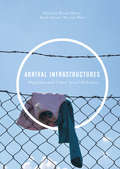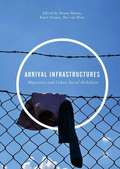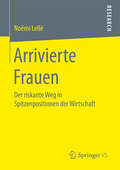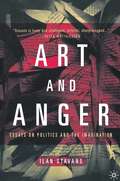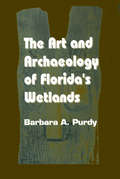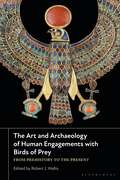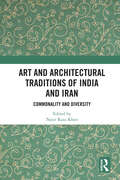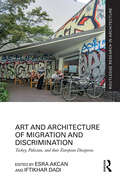- Table View
- List View
Arrival Infrastructures: Migration and Urban Social Mobilities
by Bruno Meeus Karel Arnaut Bas Van HeurThis volume introduces a strategic interdisciplinary research agenda on arrival infrastructures. Arrival infrastructures are those parts of the urban fabric within which newcomers become entangled on arrival, and where their future local or translocal social mobilities are produced as much as negotiated. Challenging the dominance of national normativities, temporalities, and geographies of “arrival,” the authors scrutinize the position and potential of cities as transnationally embedded places of arrival. Critically interrogating conceptions of migrant arrival as oriented towards settlement and integration, the volume directs attention to much more diverse migration trajectories that shape our cities today. Each chapter examines how migrants, street-level bureaucrats, local residents, and civil society actors build—with the resources they have at hand—the infrastructures that accommodate, channel, and govern arrival.
Arrival Infrastructures (PDF): Migration and Urban Social Mobilities
by Bruno Meeus Karel Arnaut Bas Van HeurThis volume introduces a strategic interdisciplinary research agenda on arrival infrastructures. Arrival infrastructures are those parts of the urban fabric within which newcomers become entangled on arrival, and where their future local or translocal social mobilities are produced as much as negotiated. Challenging the dominance of national normativities, temporalities, and geographies of “arrival,” the authors scrutinize the position and potential of cities as transnationally embedded places of arrival. Critically interrogating conceptions of migrant arrival as oriented towards settlement and integration, the volume directs attention to much more diverse migration trajectories that shape our cities today. Each chapter examines how migrants, street-level bureaucrats, local residents, and civil society actors build—with the resources they have at hand—the infrastructures that accommodate, channel, and govern arrival.
Arrival Neighborhoods in Europe since the mid-19th Century: Migrations, Cities, Infrastructures (ISSN)
by David TemplinThis book uses the concept of "arrival spaces" to examine the relationship between migration processes, social infrastructures, and the transformation of urban spaces in Europe since the mid-19th century.Case studies cover cities from London to Palermo and from Antwerp to St. Petersburg, including both metropolises and small towns. The chapters examine the emergence of settlement patterns, the functioning of arrival infrastructures, and the public representations of neighborhoods which have been shaped by internal or international migrations. By understanding these neighborhoods as spaces of arrival and as infrastructural hubs, this volume offers a new perspective on the profound impact of migration on European cities in modern and contemporary history.This volume makes a valuable contribution to both migration research and urban history and will be of interest to researchers and students studying the relationship between cities and migration in Europe’s past and present.
Arrival Neighborhoods in Europe since the mid-19th Century: Migrations, Cities, Infrastructures (ISSN)
This book uses the concept of "arrival spaces" to examine the relationship between migration processes, social infrastructures, and the transformation of urban spaces in Europe since the mid-19th century.Case studies cover cities from London to Palermo and from Antwerp to St. Petersburg, including both metropolises and small towns. The chapters examine the emergence of settlement patterns, the functioning of arrival infrastructures, and the public representations of neighborhoods which have been shaped by internal or international migrations. By understanding these neighborhoods as spaces of arrival and as infrastructural hubs, this volume offers a new perspective on the profound impact of migration on European cities in modern and contemporary history.This volume makes a valuable contribution to both migration research and urban history and will be of interest to researchers and students studying the relationship between cities and migration in Europe’s past and present.
Arrivierte Frauen: Der riskante Weg in Spitzenpositionen der Wirtschaft
by Noëmi LelléNoëmi Lellé untersucht das Phänomen der Untervertretung von Frauen im Deutschschweizer Kaderarbeitsmarkt. Die Autorin hält fest, dass umso weniger Frauen auszumachen sind, je höher eine Position ist. Bourdieus Denkwerkzeuge, insbesondere sein Konzept der männlichen Herrschaft (vgl. Bourdieu 2005) bildet die theoretische Grundlage der Analyse und das Forschungsinteresse richtet sich auf den weiblichen Habitus. Geschlecht wird als eine historisch kontingente Art des Seins definiert und Prozesse der Naturalisierung von Geschlecht und Arbeitsteilung der Produktions- und Reproduktionsarbeit werden aufgedeckt. Es wird herausgearbeitet, wie das zweigeschlechtliche Ordnungsprinzip institutionalisiert ist und permanent reziprok reproduziert wird. Diese Ordnung der Gesellschaft wird hier als Geschlechterordnung im Rahmen einer Soziologie des Geschlechts und der Arbeitssoziologie untersucht.
Arriving Where We Started: Aristotle and Business Ethics (Issues in Business Ethics #51)
by Edwin M. HartmanEdwin Hartman offers an account of his intellectual journey from Aristotle to organization theory to business ethics to an Aristotelian approach to business ethics. Aristotle’s work in metaphysics and psychology offers some insights into the explanation of behavior. Central to this sort of explanation is characteristically human rationality. Central to successful organizations is characteristically human sociability. That human beings are by nature rational and sociable is the basis of Aristotle’s ethics. Though a modern organization is not a polis in Aristotle’s sense, it has good reason to treat people as rational and sociable on the whole, and thereby to preserve the organization as a commons of people linked by something much like Aristotle’s account of strong friendship. Organizations that are successful in this respect, particularly those that deal with a nationally diverse workforce, may offer a far-reaching and attractive model.
Arrogance: Rescuing America from the Media Elite
by Bernard Goldberg#1 New York Times and award-winning journalist Bernard Goldberg takes on the arrogance that skews much of mainstream media towards the political left. In his #1 New York Times bestseller, Bias, Emmy Award-winning journalist Bernard Goldberg created a national firestorm when he exposed the liberal biases of the so-called mainstream media. Now Goldberg takes on Big Journalism and punctures the bubble in which the media elites live and work--a culture of denial where contrary views are not welcome. With blistering wit and passion, Goldberg offers a twelve-step program to help journalists overcome their addiction to slanted news and exposes the main culprits of arrogance in the media. He reveals: How the media's coverage of the Jayson Blair scandal missed far more serious problems at the New York Times. Why the media refuse to shoot straight when the subject turns to guns. Which CBS News icon is "transparently liberal," according to commentator Andy Rooney. Why some think the top journalism school in America is an intellectual gulag. How some journalists, like Bob Costas and Tim Russert, do get it-and how they think American journalism can be made better.
An Arrow Against All Tyrants: Introduction by Ian Gadd
by Richard OvertonIn 1646, Richard Overton, a Leveller, penned a political pamphlet which asserted the inalienable rights of the individual, from his cell in Newgate Gaol. Reprinted here is Overton's bold, declamatory pamphlet, with an introduction by Ian Gadd, Professor of English Literature at Bath Spa University.
Arrow Impossibility Theorems
by Jerry S. KellyArrow Impossibility Theorems is a 10-chapter text that describes existing impossibility theorems. This book explores a number of formalizations of ethical constraints of the theorems.After an introduction to the framework and notation for Arrow impossibility theorems, this book goes on discussing some concepts and an apparatus of relations among those concepts which are important for the theorems. Other chapters present some impossibility results that serve to point out serious difficulties in some plausible escape routes from the theorems of earlier chapters. The final chapter describes important areas of research that have arisen in the collective choice field in the transition away from studying the conditions of Arrow's theorem alone to the totality of all impossibility theorems.This book is intended primarily for economists.
Arsenic and Old Mustard: Chemical Problems in the Destruction of Old Arsenical and `Mustard' Munitions (NATO Science Partnership Subseries: 1 #19)
by Joseph F. BunnettMore than ten million `poison gas' shells, mortar bombs, etc., lie hidden in Europe, many of them relics from World War I. Some were fired and failed to detonate, others were abandoned in old ammunition dumps. Most retain their load of chemical warfare (CW) agents. They are turned up daily in the course of farming and construction. Many European nations have permanent departments concerned with their collection and destruction. Old munitions, when discovered, are usually heavily corroded and difficult to identify. Is it a CW munition? Or an explosive? If CW, what agent does it contain? Once identified, one has to select a destruction method. Some of the methods that have been proposed are less than perfect, and are often complicated by the presence of extraneous chemicals, either mixed with the CW agents during manufacture or formed over decades in the ground. Of particular interest are the insiders' reports on the German CW programmes of both World Wars, and the current status of Russian chemical armaments.
Art After Appropriation: Essays on Art in the 1990s
by John C. WelchmanBeginning with the first comprehensive account of the discourse of appropriation that dominated the art world in the late 1970s and 1980s, Art After Appropriation suggests a matrix of inflections and refusals around the culture of taking or citation, each chapter loosely correlated with one year of the decade between 1989 and 1999. The opening chapters show how the Second World culture of the USSR gave rise to a new visibility for photography during the dissolution of the Soviet Union around 1989. Welchman examines how genres of ethnography, documentary and travel are crossed with fictive performance and social improvisation in the videos of Steve Fagin. He discusses how hybrid forms of subjectivity are delivered by a new critical narcissism, and how the Korean-American artist, Cody Choi converts diffident gestures of appropriation from the logic of material or stylistic annexation into continuous incorporated events. Art After Appropriation also examines the creation of public art from covert actions and social feedback, and how bodies participate in their own appropriation. Art After Appropriation concludes with the advent of the rainbow net, an imaginary icon that governs the spaces of interactivity, proliferation and media piracy at the end of the millennium.John Welchman is Professor of Modern Art History, Theory and Criticism at the University of California, San Diego. He is the author of Modernism Relocated (1995) and Invisible Colors (1997); and editor of Rethinking Borders (1996), and a forthcoming three-volume anthology of the writings of LA artist MIke Kelley. Welchman has contributed to numerous journals, magazines, museum catalogues and newspapers, including Artforum; New York Times; Los Angeles Times; International Herald Tribune; Los Angeles County Museum of Art; Tate Gallery; Museum of Contemporary Art, Los Angeles; Reina Sofia, Madrid; Haus der Kunst, Munich
Art After Appropriation: Essays on Art in the 1990s
by John C. WelchmanBeginning with the first comprehensive account of the discourse of appropriation that dominated the art world in the late 1970s and 1980s, Art After Appropriation suggests a matrix of inflections and refusals around the culture of taking or citation, each chapter loosely correlated with one year of the decade between 1989 and 1999. The opening chapters show how the Second World culture of the USSR gave rise to a new visibility for photography during the dissolution of the Soviet Union around 1989. Welchman examines how genres of ethnography, documentary and travel are crossed with fictive performance and social improvisation in the videos of Steve Fagin. He discusses how hybrid forms of subjectivity are delivered by a new critical narcissism, and how the Korean-American artist, Cody Choi converts diffident gestures of appropriation from the logic of material or stylistic annexation into continuous incorporated events. Art After Appropriation also examines the creation of public art from covert actions and social feedback, and how bodies participate in their own appropriation. Art After Appropriation concludes with the advent of the rainbow net, an imaginary icon that governs the spaces of interactivity, proliferation and media piracy at the end of the millennium.John Welchman is Professor of Modern Art History, Theory and Criticism at the University of California, San Diego. He is the author of Modernism Relocated (1995) and Invisible Colors (1997); and editor of Rethinking Borders (1996), and a forthcoming three-volume anthology of the writings of LA artist MIke Kelley. Welchman has contributed to numerous journals, magazines, museum catalogues and newspapers, including Artforum; New York Times; Los Angeles Times; International Herald Tribune; Los Angeles County Museum of Art; Tate Gallery; Museum of Contemporary Art, Los Angeles; Reina Sofia, Madrid; Haus der Kunst, Munich
Art after the Hipster: Identity Politics, Ethics and Aesthetics (PDF)
by Wes HillThis book examines the complexities of the hipster through the lens of art history and cultural theory, from Charles Baudelaire’s flâneur to the contemporary “creative” borne from creative industries policies. It claims that the recent ubiquity of hipster culture has led many artists to confront their own significance, responding to the mass artification of contemporary life by de-emphasising the formal and textual deconstructions so central to the legacies of modern and postmodern art. In the era of creative digital technologies, long held characteristics of art such as individual expression, innovation, and alternative lifestyle are now features of a flooded and fast-paced global marketplace. Against the idea that artists, like hipsters, are the “foot soldiers of capitalism”, the institutionalized networks that make up the contemporary art world are working to portray a view of art that is less a discerning exercise in innovative form-making than a social platform—a forum for populist aesthetic pleasures or socio-political causes. It is in this sense that the concept of the hipster is caught up in age-old debates about the relation between ethics and aesthetics, examined here in terms of the dynamics of global contemporary art.
Art and Agency: An Anthropological Theory
by Alfred GellAlfred Gell puts forward a new anthropological theory of visual art, seen as a form of instrumental action: the making of things as a means of influencing the thoughts and actions of others. He argues that existing anthropological and aesthetic theories take an overwhelmingly passive point of view, and questions the criteria that accord art status only to a certain class of objects and not to others. The anthropology of art is here reformulated as the anthropology of a category of action: Gell shows how art objects embody complex intentionalities and mediate social agency. He explores the psychology of patterns and perceptions, art and personhood, the control of knowledge, and the interpretation of meaning, drawing upon a diversity of artistic traditions—European, Indian, Polynesian, Melanesian, and Australian. Art and Agency was completed just before Alfred Gell's death at the age of 51 in January 1997. It embodies the intellectual bravura, lively wit, vigour, and erudition for which he was admired, and will stand as an enduring testament to one of the most gifted anthropologists of his generation.
Art and Anger: Essays on Politics and the Imagination
by I. StavansFascinated by the idea of Western civilization as being a sequence of numerous misinterpretations and misrepresentations, these nineteen essays cover a broad range of topics with the unifying theme being the crossroads where politics and the imagination meet. An essay on linguistics and culture discusses the shaping of Latin America's collective identity; Peru's modern history is approached as a bloody battle between enlightenment and darkness; and in critiques of Octavio Paz and Gabriel García Márquez, Stavans reflects on the dichotomy between pen and sword in the Hispanic world. In 'Letter to a German Friend', Stavans returns to his fate as a Jew in the Southern Hemisphere, and in 'The First Book,' he connects his passion for literature to his initiation into Jewishness. Finally, in a meditation on Columbus's afterlife, he reflects on the many ways in which we reinvent ourselves in order to make sense of the chaotic world that surrounds us.
Art and Archaeology: Collaborations, Conversations, Criticisms (One World Archaeology #11)
by Ian Alden Russell Andrew CochraneThis volume presents a collection of interdisciplinary collaborations between contemporary art, heritage, anthropological, and archaeological practitioners. Departing from the proceedings of the Sixth World Archaeological Congress’s ‘Archaeologies of Art’ theme and Ábhar agus Meon exhibitions, it includes papers by seminal figures as well as experimental work by those who are exploring the application of artistic methods and theory to the practice of archaeology. Art and archaeology: collaborations, conversations, criticisms encourages the creative interplay of various approaches to ‘art’ and ‘archaeology’ so these new modes of expression can contribute to how we understand the world. Established topics such as cave art, monumental architecture and land art will be discussed alongside contemporary video art, performance art and relational arts practices. Here, the parallel roles of artists as makers of new worlds and archaeologists as makers of pasts worlds are brought together to understand the influences of human creativity.
The Art and Archaeology of Bodily Adornment: Studies from Central and East Asian Mortuary Contexts
The Art and Archaeology of Bodily Adornment examines the significance of adornment to the shaping of identity in mortuary contexts within Central and East Asia and brings these perspectives into dialogue with current scholarship in other worldwide regions. Adornment and dress are well-established fields of study for the ancient world, particularly with regard to Europe and the Americas. Often left out of this growing discourse are contributions from scholars of Central and East Asia. The mortuary contexts of focus in this volume represent unique sites and events where identity was visualized, and often manipulated and negotiated, through material objects and their placement on and about the deceased body. The authors examine ornaments, jewelry, clothing, and hairstyles to address questions of identity construction regarding dimensions such as gender and social and political status, and transcultural exchange from burials of prehistoric and early historical archaeological sites in Central Asia, China, Korea, and Japan. In both breadth and depth, this book will be of interest to students and scholars interested in the archaeology, art, and history of Central and East Asia, as well as anyone interested in the general study of dress and adornment.
The Art and Archaeology of Bodily Adornment: Studies from Central and East Asian Mortuary Contexts
The Art and Archaeology of Bodily Adornment examines the significance of adornment to the shaping of identity in mortuary contexts within Central and East Asia and brings these perspectives into dialogue with current scholarship in other worldwide regions. Adornment and dress are well-established fields of study for the ancient world, particularly with regard to Europe and the Americas. Often left out of this growing discourse are contributions from scholars of Central and East Asia. The mortuary contexts of focus in this volume represent unique sites and events where identity was visualized, and often manipulated and negotiated, through material objects and their placement on and about the deceased body. The authors examine ornaments, jewelry, clothing, and hairstyles to address questions of identity construction regarding dimensions such as gender and social and political status, and transcultural exchange from burials of prehistoric and early historical archaeological sites in Central Asia, China, Korea, and Japan. In both breadth and depth, this book will be of interest to students and scholars interested in the archaeology, art, and history of Central and East Asia, as well as anyone interested in the general study of dress and adornment.
The Art and Archaeology of Florida's Wetlands
by BarbaraA. PurdyWaterlogged archaeological sites in Florida contain tools, art objects, dietary items, human skeletal remains, and glimpses of past environments that do not survive the ravages of time at typical terrestrial sites. Unfortunately, archaeological wet sites are invisible since their preservation depends upon their entombment in oxygen-free, organic deposits. As a result, they are often destroyed accidentally during draining, dredging, and development projects. These sites and the objects they contain are an important part of Florida's heritage. They provide an opportunity to learn how the state's earliest residents used available resources to make their lives more comfortable and how they expressed themselves artistically. Without the wood carvings from water-saturated sites, it would be easy to think of early Floridians as culturally impoverished because Florida does not have stone suitable for creating sculptures. This book compiles in one volume detailed accounts of such famous sites as Key Marco, Little Salt Spring, Windover, Ft. Center, and others. The book discusses wet site environments and explains the kinds of physical, chemical, and structural components required to ensure that the proper conditions for site formation are present and prevail through time. The book also talks about how to preserve artifacts that have been entombed in anaerobic deposits and the importance of classes of objects, such as wooden carvings, dietary items, human skeletal remains, to our better understanding of past cultures. Until now this information has been scattered in obscure documents and articles, thus diminishing its importance. Our ancestors may not have been Indians, but they contributed to the state's heritage for more than 10,000 years. Once disturbed by ambitious dredging and draining projects, their story is gone forever; it cannot be transplanted to another location.
The Art and Archaeology of Florida's Wetlands
by BarbaraA. PurdyWaterlogged archaeological sites in Florida contain tools, art objects, dietary items, human skeletal remains, and glimpses of past environments that do not survive the ravages of time at typical terrestrial sites. Unfortunately, archaeological wet sites are invisible since their preservation depends upon their entombment in oxygen-free, organic deposits. As a result, they are often destroyed accidentally during draining, dredging, and development projects. These sites and the objects they contain are an important part of Florida's heritage. They provide an opportunity to learn how the state's earliest residents used available resources to make their lives more comfortable and how they expressed themselves artistically. Without the wood carvings from water-saturated sites, it would be easy to think of early Floridians as culturally impoverished because Florida does not have stone suitable for creating sculptures. This book compiles in one volume detailed accounts of such famous sites as Key Marco, Little Salt Spring, Windover, Ft. Center, and others. The book discusses wet site environments and explains the kinds of physical, chemical, and structural components required to ensure that the proper conditions for site formation are present and prevail through time. The book also talks about how to preserve artifacts that have been entombed in anaerobic deposits and the importance of classes of objects, such as wooden carvings, dietary items, human skeletal remains, to our better understanding of past cultures. Until now this information has been scattered in obscure documents and articles, thus diminishing its importance. Our ancestors may not have been Indians, but they contributed to the state's heritage for more than 10,000 years. Once disturbed by ambitious dredging and draining projects, their story is gone forever; it cannot be transplanted to another location.
The Art and Archaeology of Human Engagements with Birds of Prey: From Prehistory to the Present
by Robert J. WallisOf all avian groups, birds of prey in particular have long been a prominent subject of fascination in many human societies. This book demonstrates that the art and materiality of human engagements with raptors has been significant through deep time and across the world, from earliest prehistory to Indigenous thinking in the present day. Drawing on a wide range of global case studies and a plurality of complementary perspectives, it explores the varied and fluid dynamics between humans and birds of prey as evidenced in this diverse art-historical and archaeological record. From their depictions as powerful beings in visual art and their important roles in Indigenous mythologies, to the significance of their body parts as active agents in religious rituals, the intentional deposition of their faunal remains and the display of their preserved bodies in museums, there is no doubt that birds of prey have been figures of great import for the shaping of human society and culture. However, several of the chapters in this volume are particularly concerned with looking beyond the culture–nature dichotomy and human-centred accounts to explore perspectival and other post-humanist thinking on human–raptor ontologies and epistemologies. The contributors recognize that human–raptor relationships are not driven exclusively by human intentionality, and that when these species meet they relate-to and become-with one another. This 'raptor-with-human'-focused approach allows for a productive re-framing of questions about human–raptor interstices, enables fresh thinking about established evidence and offers signposts for present and future intra-actions with birds of prey.
The Art and Archaeology of Human Engagements with Birds of Prey: From Prehistory to the Present
Of all avian groups, birds of prey in particular have long been a prominent subject of fascination in many human societies. This book demonstrates that the art and materiality of human engagements with raptors has been significant through deep time and across the world, from earliest prehistory to Indigenous thinking in the present day. Drawing on a wide range of global case studies and a plurality of complementary perspectives, it explores the varied and fluid dynamics between humans and birds of prey as evidenced in this diverse art-historical and archaeological record. From their depictions as powerful beings in visual art and their important roles in Indigenous mythologies, to the significance of their body parts as active agents in religious rituals, the intentional deposition of their faunal remains and the display of their preserved bodies in museums, there is no doubt that birds of prey have been figures of great import for the shaping of human society and culture. However, several of the chapters in this volume are particularly concerned with looking beyond the culture–nature dichotomy and human-centred accounts to explore perspectival and other post-humanist thinking on human–raptor ontologies and epistemologies. The contributors recognize that human–raptor relationships are not driven exclusively by human intentionality, and that when these species meet they relate-to and become-with one another. This 'raptor-with-human'-focused approach allows for a productive re-framing of questions about human–raptor interstices, enables fresh thinking about established evidence and offers signposts for present and future intra-actions with birds of prey.
Art and Architectural Traditions of India and Iran: Commonality and Diversity
by Nasir Raza KhanThis book presents a comprehensive overview of the historical and cultural linkages between India and Iran in terms of art and architectural traditions and their commonality and diversity. It addresses themes such as early connections between Iran, India and Central Asia; study of the Qutb Complex in Delhi; the great immigration of Turks from Asia to Anatolia; the collaboration of Indian and Persian painters; design, ornamentation techniques and regional dynamics; women and public spaces in Shahjahanabad and Isfahan; the noble-architects of emperor Shah Jahan's reign; development of Kashmir’s Islamic religious architecture in the medieval period; role of Nur Jahan and her Persian roots in the evolution of the Mughal Garden; synthesis of Indo-Iranian architecture; and confluence of Indo-Persian food culture to showcase the richness of art, architecture, and sociocultural and political exchanges between the two countries. Bringing together a wide array of perspectives, it delves into the roots of connection between India and Iran over centuries to understand its influence and impact on the artistic and cultural genealogy and the shared past of two of the oldest civilizations and regional powers of the world. With its archival sources, this book will be useful to scholars and researchers of medieval history, Indian history, international relations, Central Asian history, Islamic studies, Iranian history, art and architecture, heritage studies, cultural studies, regional studies, and South Asian studies as well as those interested in the study of sociocultural and religious exchanges.
Art and Architectural Traditions of India and Iran: Commonality and Diversity
by Nasir Raza KhanThis book presents a comprehensive overview of the historical and cultural linkages between India and Iran in terms of art and architectural traditions and their commonality and diversity. It addresses themes such as early connections between Iran, India and Central Asia; study of the Qutb Complex in Delhi; the great immigration of Turks from Asia to Anatolia; the collaboration of Indian and Persian painters; design, ornamentation techniques and regional dynamics; women and public spaces in Shahjahanabad and Isfahan; the noble-architects of emperor Shah Jahan's reign; development of Kashmir’s Islamic religious architecture in the medieval period; role of Nur Jahan and her Persian roots in the evolution of the Mughal Garden; synthesis of Indo-Iranian architecture; and confluence of Indo-Persian food culture to showcase the richness of art, architecture, and sociocultural and political exchanges between the two countries. Bringing together a wide array of perspectives, it delves into the roots of connection between India and Iran over centuries to understand its influence and impact on the artistic and cultural genealogy and the shared past of two of the oldest civilizations and regional powers of the world. With its archival sources, this book will be useful to scholars and researchers of medieval history, Indian history, international relations, Central Asian history, Islamic studies, Iranian history, art and architecture, heritage studies, cultural studies, regional studies, and South Asian studies as well as those interested in the study of sociocultural and religious exchanges.
Art and Architecture of Migration and Discrimination: Turkey, Pakistan, and their European Diasporas (Routledge Research in Architecture)
by Esra Akcan Iftikhar DadiThis book brings together essays by established and emerging scholars that discuss Pakistan, Turkey, and their diasporas in Europe. Together, the contributions show the scope of diverse artistic media, including architecture, painting, postcards, film, music, and literature, that has responded to the partitions of the twentieth century and the Muslim diasporas in Europe. Turkey and Pakistan have been subject to two of the largest compulsory population transfers of the twentieth century. They have also been the sites for large magnitudes of emigration during the second half of the twentieth century, creating influential diasporas in European cities such as London and Berlin. Discrimination has been both the cause and result of migration: while internal problems compelled citizens to emigrate from their countries, blatant discriminatory and ideological constructs shaped their experiences in their countries of arrival. Read together, the Partition emerges from the essays in Part I not as a pathology specific to the Balkans, Middle East, or South Asia, but as a central problematic of the new political realities of decolonization and nation formation. The essays in Part II demonstrate the layered histories and multiple migration paths that have shaped the experiences of Berliners and Londoners. This analysis furthers the study of modernism and migration across the borders of, not only the nation-state, but also class, race, and gender. As a result, this book will be of interest to a broad multidisciplinary academic audience including students and faculty, artists, architects and planners, as well as non-specialist general public interested in visual arts, architecture and urban literature.
